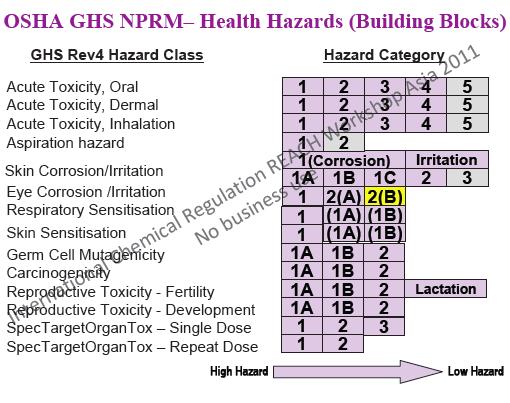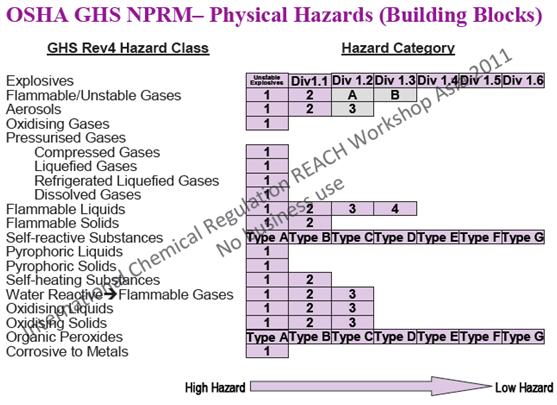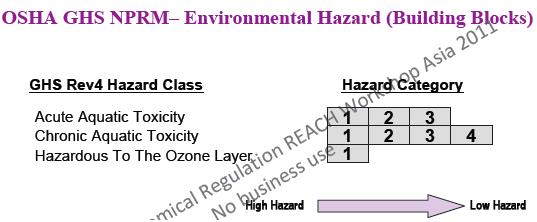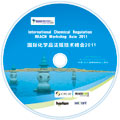30 December 2011
The United States regulate and control the chemical safety at different stages of the chemical product lifecycle. Three US main competent authorities take responsibilities for the regulation of chemicals in phrases of R&D, manufacture, transport, consumption and disposal. They are Occupational Safety & Health Administration1, Department of Transport and Consumer Product Safety Commission. Two federal agencies are responsible for specific product-related registrations or notifications. They are Environmental Protection Agency which regulates pesticides and Food and Drug Administration which regulate food, drugs and cosmetics.
This GHS presentation addresses hazard communication which includes the US hazard classification, labels and SDSs in line with the OSHA Hazard Communication Standard (HCS) under the Occupational Safety and Health Act of 19702. The US OSHA HCS applies to chemicals in the workplace for which there is exposure under normal conditions of use or in a foreseeable emergency. Another important US chemical system, the Toxic Substances Control Act3 (TSCA) executed by EPA is separate from the OSHA standards on SDSs, labels and hazard classification.
What is OSHA GHS NPRM?
In September 2009, the OSHA’s GHS Notice of Proposed Rulemaking (NPRM, a US legislature procedure) was published in Federal Register to maintain consistency with the 3rd revised United Nations GHS. The rule is aimed to implement in the US the UN's Globally Harmonized System (GHS) of Classification and Labelling of Chemicals. The proposed regulatory text contained ten parts including scope and application, hazard classification, written hazard communication program, labels and other forms of warning, safety data sheets, employee information & training, etc. The six new appendixes of OSHA GHS NPRM identified five mandatory measures regarding US GHS standards (health hazard, physical hazard, allocation of label elements, SDS and trade secret) and one non-mandatory carcinogenic classification criteria.
Some definitions are revised to keep consistent with the United Nations’ GHS. For example, Definition of “chemical” expands to “any substance or mixture of substances”; “Product identifier” can be referred as to “the name or number used for a hazardous chemical on a label or in the SDS”. “Unclassified hazard” emphasizes on the condition that “there is scientific evidence for an adverse physical or health effect but the evidence does not currently meet the specified criteria”. Based on this principle, two examples of HCS hazards that are not classified by GHS are combustible dust and simple asphyxiate.
Hazard Class and Hazard Category
OSHA GHS NPRM still follows the UN GHS (Rev 4) approach of “building blocks” in identifying the hazard category of chemicals. Health Hazards range from the highest category 1 to the lowest category 5. For physical hazards of chemicals, only “self-reactive substances” and “organic peroxides” are classified from “Type A” to “Type G”. Also “unstable explosives” under “Explosives” are sub-divided into 6 divisions. Environmental hazards fall into three Classes: “acute aquatic toxicity”, “chronic aquatic toxicity” and “hazardous to the ozone layer”.



Hazard Communication: Labels
OSHA NPRM for GHS labels defines both an outer style on shipped containers and an inner style on inner packages. However, OSHA GHS label does not have a simplified label like the Chinese counterpart does.
In labels on shipped containers, the requirements on product identifier, signal word, hazard statement(s), pictogram(s) and precautionary statement(s) are specified as compared with the former OSHA HCS.
Major changes of the OSHA GHS NPRM labels on shipped containers are displayed as follows:
- Proposing to require the GHS Precautionary Statement text
- No numbers/codification for Hazard/Precautionary statements or pictograms in NPRM;
- No label or pictogram size specifications
- No small package provisions
- Signal word, hazard statement(s), pictogram(s) located together
- If the “skull and crossbones” is included, the exclamation mark shall not appear where it is usded for acute toxicity
- No target organ limitations
- Only product identifier required for classified hazards; hazardous components must be disclosed on SDS unless they are a trade secret.
- Label revised within 3 months of becoming aware of any significant information regarding the hazards.
Hazard Communication: Safety Data Sheets and Trade Secrets
The OSHA SDS provisions are established based on GHS Table 1.5.2, the minimum information for an SDS section. A standard OSHA Safety Data Sheet contains 16 sections, among which sections 12 – 15 are non mandatory. Under each heading section, subsections are required to be lettered.
OSHA shall be provided in English, though companies may maintain copies in other languages as well. OSHA PELs and any other OELs are required. SDSs shall be updated within 3 months since the user has become aware of significant information regarding hazards or ways to protect against hazards. Companies shall provide SDSs with their initial shipment and with the first shipment after the SDS is updated.
To be consistent with the UN GHS, OSHA NPRM trade secret provisions (CBI principle) would apply to composition percentages and specific chemical identity information of hazardous substances or hazardous stances in mixtures. And trade secret provisions only apply to SDSs, as chemical names for classified hazards are not required on labels.
Currently, the final OSHA rule on hazard communication has been submitted to the US office of Management Budget in October 2011. This process could take between 30-90 days for the OMB review and US OSHA GHS rule is anticipated in 2012.
**************
1 The United States Occupational Safety and Health Administration (OSHA) is an agency of the United States Department of Labor. It was created by Congress of the United States under the Occupational Safety and Health Act 1970. Its mission is to prevent work-related injuries, illnesses, and occupational fatality by issuing and enforcing standards for workplace safety and health. The agency is headed by a Deputy Assistant Secretary of Labor.
2 The Occupational Safety and Health Act is the primary federal law which governs occupational health and safety in the private sector and federal government in the United States. It was enacted by Congress in 1970 and was signed by President Richard Nixon on December 29, 1970. Its main goal is to ensure that employers provide employees with an environment free from recognized hazards, such as exposure to toxic chemicals, excessive noise levels, mechanical dangers, heat or cold stress, or unsanitary conditions.
3 The US Toxic Substances Control Act, or TSCA, passed by the United States Congress in 1976, regulates the introduction of new or already existing chemicals. TSCA does not separate chemicals into categories of toxic and non-toxic. Rather it prohibits the manufacture or importation of chemicals that are not on the TSCA Inventory (or subject to one of many exemptions). Generally, manufacturers must submit premanufacturing notification to the U.S. Environmental Protection Agency (EPA) prior to manufacturing (or importing) new chemicals for commercial purposes. There are notable exceptions, including one for research and development, and for substances regulated under other statutes such as the Federal Food, Drug, and Cosmetic Act and the Federal Insecticide, Fungicide, and Rodenticide Act. New chemical notifications are reviewed by the agency and if the agency finds an "unreasonable risk to human health or the environment," it may regulate the substance in a variety of ways, from limiting uses or production volume to outright banning them.









